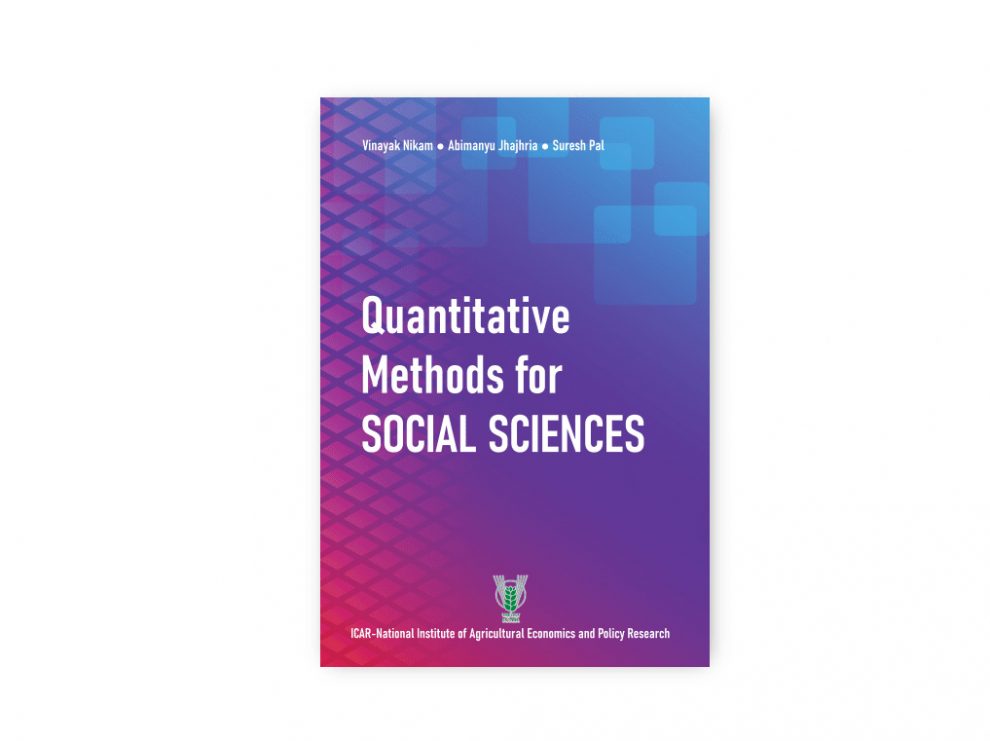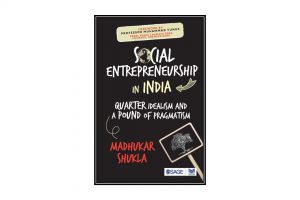Quantitative Methods for Social Sciences
Editors: Vinayak Nikam, Abimanyu Jhajaria and Suresh Pal (2019)
Published by: Director, ICAR-National Institute of Agricultural Economics and Policy Research
ISBN: 978-81-940080-2-6
Pages: 400
Social science is all about finding evidence for various social phenomena. However, getting evidence through objective research methods continue to be a major challenge for researchers. This is especially because application contexts vary and the data to support their findings may not be readily available. Assessing the impact of field level interventions over a period of time, making accurate predictions regarding dynamic factors in the sector, and forecasting trends using models and signaling changes are some of the challenges. This is particularly important when the social scientists are working to make an impact at multiple levels or arguing for a policy change. Familiarity with the various research tools and techniques are essential to address these challenges. This is even more important when publishing in high impact journals.
Thus, there is a demand for information on research methods for social sciences by both researchers and research scholars, for use as a ready reference. However, considering the diversity of the methods and differences in the application contexts, such kind of publications are not readily available. Further, many a time, there are good reference materials on research methods, but with major focus on the theoretical tenets and little emphasis on its practical application or utility. This is more critical if specific software products are recommended for the analysis part. In such a context, there exists a great demand for a comprehensive reference guide, not only for researchers, but also for research scholars and other social science professionals. The book Quantitative Methods for Social Sciences is an excellent tool kit, that caters to this demand with a clear focus on a ‘how to do’ approach.
The book is divided into six sections, namely, Measures of interdependence of variables, Regression analysis, Time series analysis, Impact assessment methods, Growth analysis and other methods. 36 chapters covering various qualitative and quantitative research techniques. The first section, ‘Measures of interdependence of variables’ basically deals with qualitative research techniques, such as Multidimensional scaling, Correspondence analysis and Cluster analysis, as well as dimensionality reduction techniques such as Principal component analysis. Complexities of most social phenomena require an investigator to collect observations on different variables and uncover the hidden structure in the multidimensional data in order to derive meaningful conclusions. Thus, this section provides sound exposure and understanding on various exploratory and multivariate methods, commonly used for studying interdependence of variables.
The second section is dedicated to different types of regression analysis – linear (ARIMA) and non-linear (GARCH, ANN) regression analysis, qualitative regression models such as probit, logit and tobit, panel data regression, simultaneous equation model and discriminant function analysis. Within multiple types of regression models, it is important to choose the best-suited technique based on type of independent and dependent variables, dimensionality in the data and other essential characteristics of the data. The book gives clear guidance to the reader in this direction. Sample data sets are analyzed mostly using R software which is demonstrated and results are interpreted in simple language.
In the next section, various forecasting models, such as Hybrid time series models, and latest research trends like Artificial Neural Network for time series modelling are discussed. The basis of forecasting techniques is entirely on patterns and pattern changes by analyzing historical data. The next chapter deals with impact assessment methods that could be of great use to all social science researchers, as it discusses a wide range of research techniques. The basic concept of impact evaluation stems from the causal inference theories in statistics. Generally, impact assessment methods aim at estimating the change in value of outcome variable of the units receiving the treatment in comparison to the untreated units. Assessing impact in the absence of a suitable counterfactual is the major challenge in observational studies. This chapter presents a number of quasi experimental methods such as propensity score matching, difference in difference approach, synthetic control method, and regression discontinuity, relative to this purpose. Moreover, techniques for measuring the impact at a macro level like the economic surplus approach is also covered in this section.
Quantitative analysis of development policies is critical for informed decision making with regard to a number of sectors – trade, taxation, climate change, etc. Given this focus, the fifth section of the book gives a detailed account of Computable general equilibrium models, Total factor productivity using data envelopment analysis as well as stochastic production function.
The last section of the publication is dedicated to introducing a variety of novel techniques. These include Social Network Analysis (SNA), Structural Equation Modeling (SEM), Partial Equilibrium Models (PEM) and Analytical Hierarchical Process (AHP). While SNA is used for value chain mapping and for studying adoption patterns, SEM is a multivariate technique for analysis of covariance structures. Similarly, PEM are widely used in sector-specific policy analysis whereas AHP is a multi-criteria decision tool. Artificial intelligence, machine learning, and big data analytics are the new tools deployed in the agricultural sector for analyzing voluminous data to make predictions. These tools and techniques have gained currency among social scientists only recently.
This book is the output of a 21-day summer school, ‘Quantitative Methods in Social Sciences’, held at ICAR-National Institute of Agricultural Economics and Policy Research (ICAR-NIAP), New Delhi, in which 25 researchers from agricultural social sciences disciplines participated. All the chapters were contributed by the subject matter experts who handled various sessions of the workshop, based on well-referenced sources.
Most of the chapters start with the basic theoretical aspects of the technique/method along with suitable illustrations, including stepwise screenshots of the software part and interpretation of the results. Altogether, the book provides a comprehensive overview of multivariate and forecasting techniques, impact assessment methodologies, growth analysis and other important methods used in social science research. Thus the book will easily grab the attention of any social scientist.
As a researcher with a background in agricultural extension, I was fascinated upon reading the chapters on regression analysis and impact assessment methodologies. The range of techniques discussed for estimating causal effect in observational studies will be especially useful to researchers (like me) in assessing the impact of field-level interventions and making the crucial scaling decisions. Similarly, the section on index construction with suitable illustrations may greatly benefit research scholars. As for agricultural economists most of the chapters may be useful depending on their area of interest.
However, from the perspective of a reader, some chapters (such as Economic surplus approach, Multi objective programming) are too descriptive on the theoretical background. It would have been much more attractive if such content was trimmed to give precise information with exhaustive focus on its application. Furthermore, the authors have not mentioned the intended audience for this publication as it contains basic research methods on one hand and advanced techniques on the other. Apart from providing greater appeal to readers, making a pitch on the importance of using each method would have added more value to the publication. Apart from these, the layout of the chapters could have been improved by presenting the key information and application context of each technique in the beginning, to make it more user-friendly.
To make best use of the resources and tools in this publication, the reader should have firsthand knowledge of various software (R, STATA, SPSS, etc.) used in the illustration part. In many chapters, the codes for running the analysis part in a particular software are given at the end. Given the very focus of this publication, I urge the publisher, ICAR- NIAP, to compile all such codes, commands, and sample data and make it available as an online resource on their website for the benefit of all readers.
Understanding the basic assumptions and analysis methods can help the researchers to appropriately design and analyze evaluation studies. Though there are publications in research techniques available in the disciplines of agricultural economics and agricultural extension separately, there aren’t many books which cater to the needs of researchers from both these disciplines. Therefore, this publication, Quantitative Methods for Social Sciences, plugs this gap. While experienced researchers can use it to brush up their knowledge, the book will aptly serve as a beginner’s guide for young scholars. As a reader, I recommend this book to research scholars in agricultural social sciences, as well as early career researchers.
Sreeram Vishnu

Dr Sreeram Vishnu, Assistant Professor (Agricultural Extension), Regional Agricultural Research Station (RARS), Ambalayavayal, Wayanad, Kerala (sreeram.vishnu@kau.in).





One of the “must have” books for a social scientist who wish to know various quantitative techniques (both basic and advanced) applied in social science research. The authors deserve a credit for bringing a diverse but valuable information in a book form to help the budding social scientists. Dr Sreeram’ s review of this book is more objective and balanced from a “practitioners view”. I wish to add few more comments, from an Extension scientists perspective.
1. The choice of , and sometimes development of “customized” quantitative methods, to understand and interpret relationships in the social science data especially from behavioral sciences like extension is a tricky aspect. Its because of, every quantitative method is developed based on some “logic”, guided by the subject matter for which it is developed. For example, biometrics is based on genetics and plant breeding, econometrics is developed to understand economics phenomenon.Similarly psychometrics is a statistical modeling of human behavior. It is very important for any user to understand this “logic” as guided by the subject matter, before choosing a quantitative method.
2. Application of advanced quantitative techniques using software require specialized training. ICAR-NIAP is conducting several quantitative techniques training programmes for social scientitists, However, these trainings are focused more on the techniques developed for the subject matter of economics, though the current book has few methods for extension as well. We need to have a customized form of quantitative techniques training package for extension discipline. Because extension research deals with direct manipulation of human behaviour (mostly action research with a mixed methods approach) which economics derive insights mostly in “ex-post facto” or in “ex-ante” from.
There is no doubt that quantitative techniques are needed to interpret qualitative data to add credibility and reliability for the investigation, particularly in a discipline like Agricultural Extension But at the same time these sophisticated techniques should not be used just for the sake of using Even very simple technique may be sufficient enough to explain some qualitative data Hence at most care should be exercised in choosing an appropriate technique and it’s correct usage in Extension Otherwise no meaningful conclusions could be arrived at
Very need driven book. We need to develop our competencies in quantitative methods. I fortunately got a hard copy some time back, asked students to buy it. Congratulations to the authors & to AESA for book review.